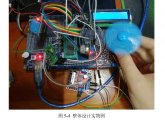基于单片机的智能家居控制系统的设计(任务书,开题报告,外文翻译,论文17000字)
摘要
本次设计是基于STC89C52单片机作为核心控制器件的智能家居控制系统,目的是实时监控家居环境参数的变化,并针对这些变化进行相应的反馈调节。本次设计结合了传感器技术,利用温湿度传感器模块DHT11及光强传感器GY-30分别对室内的温度,光强和烟雾这些重要的室内环境参数进行实时检测和显示,并且根据光照强度自动控制窗帘打开和关闭,采用PWM调速原理根据温湿度对排气扇进行无极自动调速,来达到对室内环境进行反馈调节的目的。同时利用到空气质量传感器MQ-135来对室内空气进行监控,如果检测到烟雾、燃气等污染气体则进行声光报警并自动开启换气扇。
本设计的试验结果表明:本次设计能够对室内环境参数进行监控并且实现相应的反馈调节,能够让大家充分感受到智能家居生活所提供的便利和高效。而且本系统具有稳定高效,设计成本较小,具有很大扩展空间等优点,对于智能家居控制系统的研究及发展具有一定的参考价值。
关键词: 传感器技术;STC89C52单片机;智能家居;PWM调速
Abstract
This design is based on the STC89C52 microcontroller as the core control device of the smart home control system, the purpose is to monitor real-time changes in the home environment parameters, and for these changes in the corresponding feedback regulation. This design incorporates sensor technology. The temperature and humidity sensor module DHT11 and the light intensity sensor GY-30 are used to detect and display indoor temperature, light intensity, and smoke, which are important indoor environmental parameters, and automatically control the curtains according to the light intensity. Turning on and off, the principle of PWM speed control is used to automatically adjust the speed of the exhaust fan according to the temperature and humidity to achieve the purpose of feedback adjustment of the indoor environment. At the same time, the air quality sensor MQ-135 is used to monitor the indoor air. If smoke, gas and other polluting gases are detected, sound and light alarms are performed and the ventilation fan is automatically turned on.
The experimental results of this design show that this design can monitor the indoor environment parameters and implement corresponding feedback adjustments, which will allow everyone to fully feel the convenience and efficiency provided by smart home life. Moreover, the system has the advantages of stability and high efficiency, low design cost, and large space for expansion, and has certain reference value for the research and development of the smart home control system.
Key Words :sensor technology; STC89C52 MCU; smarthome; PWM speed regulation
系统设计的主要任务
本次设计为基于STC89C52单片机的智能家居控制系统,使用多传感器感知监控家中环境参数变化并能够实现一定的反馈调节环境参数功能。在本次设计过程当中,分别利用温湿度传感器、光强传感器、烟雾传感器分别对室内的温湿度、光强、烟雾这些环境参数进行实时监控,并根据这些检测的结果通过单片机控制相应的执行器件以实现对环境的反馈调节,根据温度检测结果通过单片机控制排气扇的转速,使室内达到一个舒适的温度环境;利用光强检测结果控制步进电机实现窗帘的自动开关,使人们的生活更加便利和智能;当在室内检测到有害气体时进行声光报警以提醒居民及时采取相关措施预防由火灾、燃气泄漏等造成的灾难,并自动开启排气扇紧急排气处理,提高室内生活的安全性。通过这些传感器实时检测环境参数,并通过单片机控制相应的执行器件进行反馈调节,来达到营造一个更加舒适、安全、智能化的居家环境的目的。
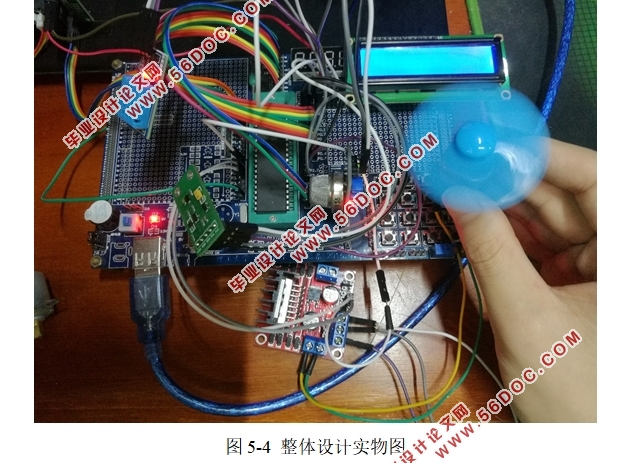
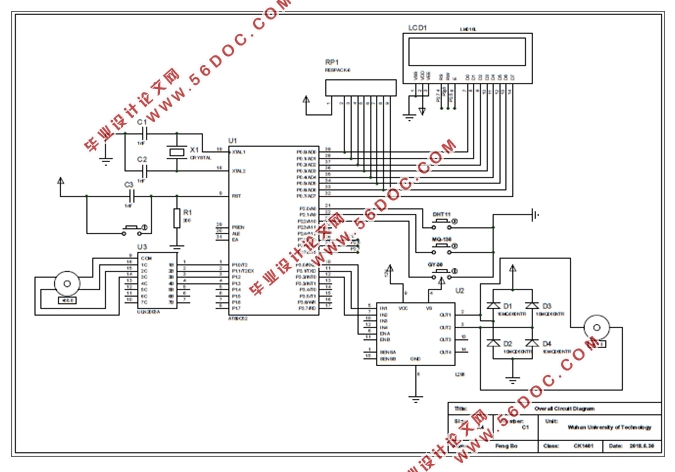
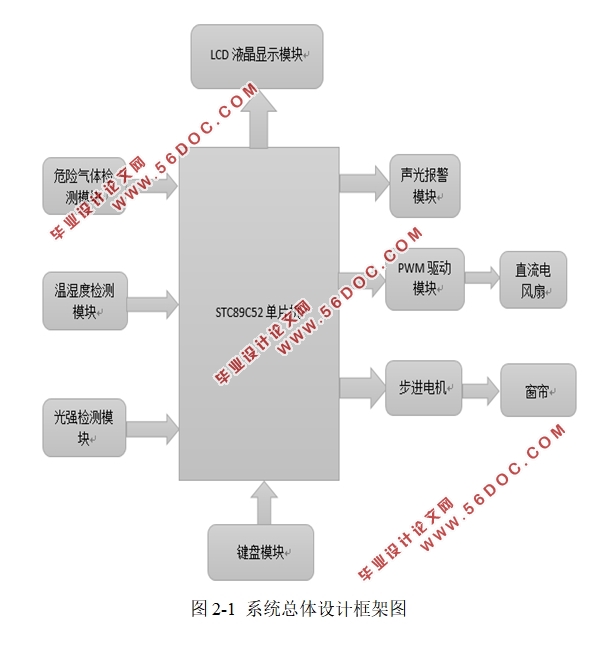
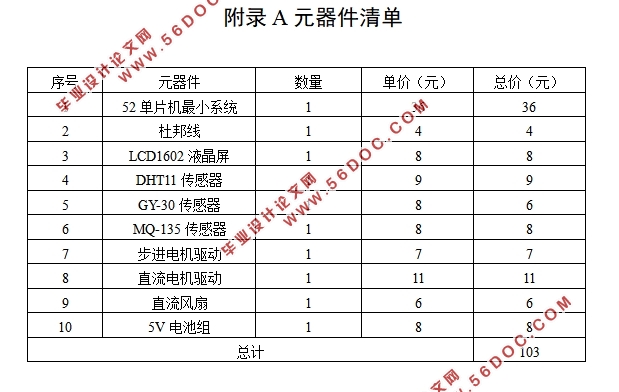

目录
第1章绪论 1
1.1 研究背景 1
1.2 研究的目的及意义 2
1.3 系统设计的主要任务 2
第2章方案设计 3
2.1 系统方案介绍 3
2.2 系统功能介绍 3
2.3 系统总体结构设计 4
第3章系统硬件设计 5
3.1 单片机STC89C52介绍 5
3.1.1 STC89C52芯片介绍 5
3.1.2 时钟电路与复位电路设计 6
3.2 LCD1602显示模块 8
3.2.1 LCD1602原理及特性介绍 8
3.2.2 LCD1602引脚及与单片机的接口介绍 9
3.3 温湿度检测模块 10
3.3.1 DHT11传感器简介 11
3.3.2 DHT11与单片机之间的通讯介绍 11
3.4 光强检测模块 12
3.4.1 GY-30传感器简介 13
3.4.2 IIC总线通路 14
3.5 烟雾检测模块 15
3.6 声光报警模块 16
3.6.1 蜂鸣器电路设计 16
3.6.2 LED电路设计 17
3.7 步进电机模块 18
3.8 L298N电机驱动模块 19
3.8.1 L298N的工作原理 19
3.8.2 L298N电机驱动电路设计 19
第4章系统软件设计 21
4.1 主程序设计 21
4.2 传感器程序设计 23
4.2.1 温湿度传感器子程序设计 23
4.2.2 光强传感器子程序设计 24
4.2.3 烟雾传感器子程序设计 24
4.3 LCD1602液晶显示子程序设计 25
4.4 输出控制程序设计 26
4.4.1 步进电机驱动子程序设计 26
4.4.2 直流电机驱动子程序设计 27
4.5 PID算法程序设计 28
第5章仿真与实物调试 30
5.1 PID调速仿真 30
5.2 实物调试 31
5.2.1 实物演示 31
5.2.2 调试所遇问题及解决方法 32
第6章总结与展望 34
参考文献 35
附录A 元器件清单 36
附录B 硬件电路图 37
附录C 程序代码 38
致谢 55
|
